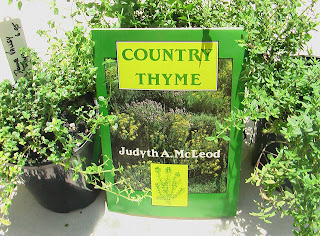True wild mother-of-thyme Thymus serpyllum growing at high altitude in Provence on Mont Ventoux
No plant really enjoys being trodden on despite the optimistic old saying:
'Like a chamomile bed
The more it is trodden
The more it will spread'
So, despite romantic inclinations and a long love affair with Francis Bacon's Elizabethan essay 'On Gardens' I have never created a path made completely of herbs. I suspect Bacon's description of his dreamed of future pleasure garden never eventuated exactly according to his plans: "I will direct that alleys be planted with fragrant herbs, Burnet, Wild Thyme and Water Mints which perfume the air most delightfully, being trodden on and crushed so that you may have the pleasure when you walk."
A path of flagstones with the spaces filled with gravel and planted with carpeting herbs is a much more rugged option. Herbs thrive in the gravel with their roots running cool beneath the flat stones just as they are found in nature. Two other options are a densely woven raised carpet for sumptuous summer reclining, and a raised herb covered seat known as a 'turf seat', a favourite in late medieval and Tudor times. (My book 'In A Unicorn's Garden' about medieval gardens, plants and those who used them gives a description of how they are made).
My favourite carpeting herbs are the thymes. Thyme species fall into two broad types. Some are little subshrubs like lemon thyme (T. x citriodora), mastic thyme (T. mastichina) which is perfect for barbequed meats, 'Oregano' Thyme (T. pulegioides), 'Broadleaf English' (a hybrid of T. vulgaris), 'Fragrantissimus (T. vulgaris) and common thyme (T. vulgaris) The other group are spreading thymes that knit the earth with a dense fragrant very low-growing carpet. The thymes flower in summer, and a mixture planted about 50 to 60 cm apart will soon meet and mingle to produce a medieval tapestry of gentle colours.
There has been a taxonomic revision of the genus Thymus in recent times. Most of the named varieties of spreading thymes have been assigned away from T. serpyllum, the true and actually rare mother-of-thyme to T. pulegioides, and T. praecox subsp. arcticus so you might find them in nurseries under any of these names The flower colours range from white to variations on pink to rich crimson and purple and all have scented foliage. Among the prettiest of the carpeting thymes are 'Pink Chintz' with mid-pink flowers, the ancient white flowered'Alba' or 'Albus', 'Snowdrift' (also white) 'Coccineus' (crimson red), 'Woolly' with furry grey foliage, slightly variegated 'Mayfair', 'Annie Hall' (pale pink), 'Lars Hall' with pink flowers, 'Aureus' with golden foliage and pale pink flowers, and intensely lemon scented 'Lemon Curd' and tiny leafed 'Minus' (all now designated T. praecox subsp. arcticus). 'Pink Chintz' has soft grey-green foliage and clear pink flowers while fragrant 'Doone Valley' is dark green generously speckled with gold. Caraway thyme T. herba-barona is another spreading very low growing thyme with a strong sweet caraway seed scent and rose-lilac flowers.
Variegated 'Doone Valley' Thyme (left)
Creeping Corsican mint Mentha requienii forms a dense carpet of tiny emerald green leaves which are intensely scented of fresh mint. It prefers a moist lightly shaded area and will not take much foot traffic, so I prefer to plant it in wide shallow pots in moist semi-shade. At least the odd elf will be able to roll around on it. But pennyroyal Mentha pulegium, while needing moist soil, is happy in full sun and will take light foot traffic. It is at its best forming a tight emerald carpet between flagstones The flowers are a pretty lavender and are born in whorls up the flowering stems By the way pennyroyal is poisonous to dogs so avoid using flea treatments involving collars impregnated with pennyroyal oil and the use of a pennyroyal tea. Pet pillows containing dried pennyroyal are safe. The oil was used in the past as an abortifacient but it is dangerous, having a high toxicity and causing liver damage to the mother. Generally speaking, there are much better mints to flavour food and pennyroyal is better kept for ornamental use, for its delicious refreshing mint 'hit' in the garden, and as an ingredient in pet pillows.
Deliciously scented Caraway Thyme Thymus herba-barona (right) takes its name as a flavouring for the vast roasted Baron of Beef (a double sirloin of beef)
The perennial matting Roman Chamomile Chamaemelum nobile makes a delightful fast spreading, fresh green, dense lawn for a sunny position. The soft finely divided foliage is scented strongly of fresh green apples. For those not wanting to tangle with bees as they dream sunny hours away on their turf seat, the form 'Treneague' is a non-flowering strain. The prettiest form is 'Flore Plena' with prolific very double white flowers. Prepare the ground before planting in the same way as for turf, making sure that it is weed free and evenly smoothed over. Regular weeding and watering is vital while establishing these fragrant carpets.

If you share my love of antique plants and garden history you may like to look for one of my latest books 'In A Unicorn's Garden' (gorgeously produced by Murdoch Books covering the history of medieval gardens, their plants and those who tended them, lavishly illustrated in full colour, 288 pages) on Amazon sites at www.amazon.co.uk (in the UK) or www.amazon.com (in the USA) or in your favourite bookstore. My book 'Heritage Gardening' (published by Simon and Schuster, illustrated in full colour throughout, 256 pages ) is available through my website www.honeysuckle-cottage.com.au as is 'Country Thyme' (above, sent to the USA, UK, and NZ for AU $20 total). Click on the Products and Gifts button on the home page. You can also link to my author site with blogs, and my cottage blogs, using the links on the home page.
Happy gardening!
© Judyth McLeod









